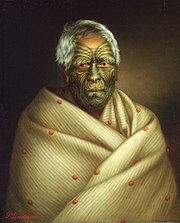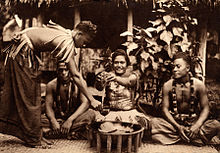Polynesians
| |||||||||||||||||||||||||||||||||||||||
Read other articles:

My Little Pony: Equestria Girls - Legend of EverfreePoster penayangan perdanaBerdasarkanKarakteroleh Lauren Faust Ditulis olehKristine SongcoJoanna LewisSutradaraIshi RudellPengisi suara Tara Strong Rebecca Shoichet Ashleigh Ball Andrea Libman Tabitha St. Germain Cathy Weseluck Enid-Raye Adams Brian Doe MusikWilliam AndersonNegara asal Kanada Amerika Serikat Bahasa asliBahasa InggrisProduksiProduserAngela BelyeaPenyuntingShannon ArchibaldTom HarrisDurasi73 menitRumah produksi DHX Med…

Steponas Kairys Deputi Jurubicara SeimasMasa jabatan2 Juni 1926 тАУ 17 Desember 1926Menteri Suplai dan PanganMasa jabatan12 April 1919 тАУ 7 Oktober 1919Perdana MenteriMykolas Sle┼╛evi─Нius Informasi pribadiLahir(1879-01-03)3 Januari 1879U┼╛nev─Ч┼╛iai dekat Ukmerg─ЧMeninggal16 Desember 1964(1964-12-16) (umur 85)Brooklyn, ASMakamPemakaman Petra┼бi┼лnaiPartai politikPartai Sosial Demokrat Lithuania (1900-35)Suami/istriAlaiza Pashkevich (m. 1912-1916; kematiannya) Ona Leonait…

Village in Vale of Glamorgan, Wales Sign in the village Ystradowen Church Ystradowen is a small village twelve miles west of Cardiff, located in Penllyn community in the Vale of Glamorgan in south Wales; its nearest town is Cowbridge which is about three miles to the south. The village was served by Ystradowen railway station between 1865 and 1951. The name Ystradowen means Owen's Valley in English. Local amenities include St Owain's parish church, The White Lion public house, Tudor Garage and S…

уАМф┐Дф║еф┐ДуАНщЗНхоЪхРСшЗ│цндуАВхЕ│ф║ОхЕ╢ф╗ЦчФиц│Хя╝Мшп╖шзБуАМф┐Дф║еф┐Д (ц╢Ицнзф╣Й)уАНуАВ ф┐Дф║еф┐Дх╖Ю ч╛ОхЬЛшБФщВжх╖ЮState of Ohio х╖ЮцЧЧх╖Юх╛╜ч╢╜шЩЯя╝Ъф╕ГшСЙцЮЬф╣Лх╖ЮхЬ░хЫ╛ф╕нщлШф║ощГихИЖф╕║ф┐Дф║еф┐Дх╖ЮхЭРцаЗя╝Ъ38┬░27'Nя╝Н41┬░58'N, 80┬░32'Wя╝Н84┬░49'WхЫ╜хо╢ ч╛ОхЬЛхКахЕешБпщВж1803х╣┤3цЬИ1цЧея╝МхЬи1953х╣┤8цЬИ7цЧеш┐╜ц║пщаТхоЪя╝Ичмм17ф╕кхКахЕешБФщВжя╝ЙщжЦх║ЬхУехАлх╕Гя╝ИхПКцЬАхдзхЯОх╕Вя╝ЙцФ┐х║Ь тАв х╖ЮщХ┐я╝ИшЛ▒шпня╝ЪList of Governors of {{{Name}}}]]я╝Й тАв …

Alexander Calder Alexander Calder (Lawnton, 22 luglio 1898 тАУ New York, 11 novembre 1976) ├и stato uno scultore statunitense. Alexander Calder 1968. ├И famoso per l'invenzione di grandi sculture di arte cinetica chiamate mobile. Oltre alle opere di scultura, mobile e stabile, Alexander Calder si dedic├▓ anche alla pittura, alle litografie e alla progettazione di giocattoli, arazzi, tappeti e gioielli. Indice 1 Biografia 2 Carriera artistica 2.1 Il Circo Calder - Le Mobiles 2.2 Le Stabiles 2.3 L…

Pour les articles homonymes, voir Arabie (homonymie). Plaque arabique ├Йponyme Arabie Composition Lithosph├иre oc├йanique et continentale Fronti├иres Dorsale de la mer Rouge Superficie 0,12082 st├йradians D├йplacement ┬╖ Direction : ┬╖ Vitesse : nord-est4,65 cm/an(r├йf├йrentiel : plaque africaine) Rotation ┬╖ Vitesse : ┬╖ P├┤le eul├йrien : 1,161 6 ┬░/Ma59┬░ 66' N 33┬░ 19' O(r├йf├йrentiel : plaque pacifique) modifier La plaque arabique est une pl…

Ivorian footballer (born 1991) Jean Micha├лl Seri Seri training with Nice in 2018Personal informationFull name Jean Micha├лl Seri[1]Date of birth (1991-07-19) 19 July 1991 (age 32)Place of birth Grand-B├йr├йby, Ivory CoastHeight 1.68 m (5 ft 6 in)[2]Position(s) Central midfielderTeam informationCurrent team Hull CityNumber 24Youth career2007тАУ2010 Africa Sports d'AbidjanSenior career*Years Team Apps (Gls)2010тАУ2013 ASEC Mimosas 16 (1)2012тАУ2013 тЖТ Porto B …

хпЖше┐ше┐цпФх╖Ю хУеф╝жх╕ГхЯОх╕Вч╢╜шЩЯя╝ЪPossum TownхУеф╝жх╕Гф╜Нф║ОхпЖше┐ше┐цпФх╖ЮчЪДф╜Нч╜охЭРцаЗя╝Ъ33┬░30тА▓06тА│N 88┬░24тА▓54тА│W / 33.501666666667┬░N 88.415┬░W / 33.501666666667; -88.415хЫ╜хо╢ ч╛ОхЬЛх╖ЮхпЖше┐ше┐цпФх╖ЮхО┐цЬЧхЕ╣хО┐хзЛх╗║ф║О1821х╣┤цФ┐х║Ь тАв х╕ВщХ┐ч╜Чф╝пчЙ╣┬╖хП▓хпЖцЦп (ц░Сф╕╗хЕЪ)щЭвчзп тАв цА╗шоб22.3 х╣│цЦ╣шЛ▒щЗМя╝И57.8 х╣│цЦ╣хЕмщЗМя╝Й тАв щЩ╕хЬ░21.4 х╣│цЦ╣шЛ▒щЗМя╝И55.5 х╣│цЦ╣хЕмщЗМя╝Й тАв ц░…

Victory column in Kyiv, Ukraine Independence Monument╨Ь╨╛╨╜╤Г╨╝╨╡╨╜╤В ╨Э╨╡╨╖╨░╨╗╨╡╨╢╨╜╨╛╤Б╤В╤ЦIndependence Monument in Maidan Nezalezhnosti50┬░26тА▓58.3тА│N 30┬░31тА▓31.4тА│E / 50.449528┬░N 30.525389┬░E / 50.449528; 30.525389LocationKyiv, UkraineHeight61 m (200 ft) The Independence Monument (Ukrainian: ╨Ь╨╛╨╜╤Г╨╝╨╡╠Б╨╜╤В ╨Э╨╡╨╖╨░╨╗╨╡╠Б╨╢╨╜╨╛╤Б╤В╤Ц, romanized: Maidan Nezalezhnosti) is a victory column located on Maidan Nezalezhnosti (Independence Square) in …

╨г ╤Н╤В╨╛╨│╨╛ ╤В╨╡╤А╨╝╨╕╨╜╨░ ╤Б╤Г╤Й╨╡╤Б╤В╨▓╤Г╤О╤В ╨╕ ╨┤╤А╤Г╨│╨╕╨╡ ╨╖╨╜╨░╤З╨╡╨╜╨╕╤П, ╤Б╨╝. ╨У╨╛╤В╤Л (╨╖╨╜╨░╤З╨╡╨╜╨╕╤П). ╨У╨╛╤В╤Л ╨У╨╛╤В╨╕╤З╨╡╤Б╨║╨╕╨╣ ╤Б╤В╨╕╨╗╤М ╨▓ ╨╛╨┤╨╡╨╢╨┤╨╡ ╨Т╨╛╨╖╨╜╨╕╨║╨╜╨╛╨▓╨╡╨╜╨╕╨╡ ╨║╨╛╨╜╨╡╤Ж 1970-╤Е ╨Т╨╡╨╗╨╕╨║╨╛╨▒╤А╨╕╤В╨░╨╜╨╕╤П ╨У╨╛╨┤╤Л ╤А╨░╤Б╤Ж╨▓╨╡╤В╨░ 1980-╨╡ ╨Э╨░╨┐╤А╨░╨▓╨╗╨╡╨╜╨╜╨╛╤Б╤В╤М ╨╝╤Г╨╖╤Л╨║╨░╨╗╤М╨╜╨░╤П ╨а╨░╤Б╨┐╤А╨╛╤Б╤В╤А╨░╨╜╨╡╨╜╨╕╨╡ ╨Х╨▓╤А╨╛╨┐╨░╨Р╨╝╨╡╤А╨╕╨║╨░╨Р╨╖╨╕╤П ╨Р╨▓╤Б╤В╤А╨░╨╗╨╕╤П ╨н╨╗╨╡╨╝╨╡╨╜╤В╤Л ╨У╨╛╤В╨╕╤З╨╡╤Б╨║╨░╤П ╨╝╤Г╨╖╤Л╨║╨░╨У╨╛╤В╨╕╤З╨╡╤Б╨║╨░╤П ╨╝╨╛╨┤╨…

Air Terjun WeraAir Terjun WeraAir Terjun WeraLokasi Air Terjun Wera di SulawesiLokasi Balumpewa, Kabupaten SigiKoordinat1┬░02тА▓40.3тА│S 119┬░51тА▓01.5тА│E / 1.044528┬░S 119.850417┬░E / -1.044528; 119.850417Koordinat: 1┬░02тА▓40.3тА│S 119┬░51тА▓01.5тА│E / 1.044528┬░S 119.850417┬░E / -1.044528; 119.850417Tinggi total80 m Air Terjun Wera merupakan air terjun yang terletak di Desa Balumpewa, Dolo Barat, Kabupaten Sigi, Sulawesi Tengah. Air terjun ini …

┘К┘Б╪к┘В╪▒ ┘Е╪н╪к┘И┘Й ┘З╪░┘З ╪з┘Д┘Е┘В╪з┘Д╪й ╪е┘Д┘Й ╪з┘Д╪з╪│╪к╪┤┘З╪з╪п ╪и┘Е╪╡╪з╪п╪▒. ┘Б╪╢┘Д╪з┘Л╪М ╪│╪з┘З┘Е ┘Б┘К ╪к╪╖┘И┘К╪▒ ┘З╪░┘З ╪з┘Д┘Е┘В╪з┘Д╪й ┘Е┘Ж ╪о┘Д╪з┘Д ╪е╪╢╪з┘Б╪й ┘Е╪╡╪з╪п╪▒ ┘Е┘И╪л┘И┘В ╪и┘З╪з. ╪г┘К ┘Е╪╣┘Д┘И┘Е╪з╪к ╪║┘К╪▒ ┘Е┘И╪л┘В╪й ┘К┘Е┘Г┘Ж ╪з┘Д╪к╪┤┘Г┘К┘Г ╪и┘З╪з ┘И╪е╪▓╪з┘Д╪к┘З╪з. (╪п┘К╪│┘Е╪и╪▒ 2018)Learn how and when to remove this message 44┬░ ╪о╪╖ ╪╣╪▒╪╢ 44 ╪м┘Ж┘И╪и ╪о╪▒┘К╪╖╪й ┘Д╪м┘Е┘К╪╣ ╪з┘Д╪е╪н╪п╪з╪л┘К╪з╪к ┘Е┘Ж ╪м┘И╪м┘Д ╪о╪▒┘К╪╖╪й ┘Д╪м┘Е┘К╪╣ ╪з┘Д╪е╪н╪п╪з╪л┘К╪з╪к ┘Е┘Ж ╪и┘К┘Ж╪║ ╪к╪╡╪п┘К╪▒…

CJ10 Stasiun TomidahamaхпМчФ░ц╡ЬщзЕStasiun JR TomidhamaLokasi20-18 Tomidahama-cho, Yokkaichi-shi, Mie-ken 510-8008JepangKoordinat34┬░59тА▓50тА│N 136┬░38тА▓59тА│E / 34.9973┬░N 136.6498┬░E / 34.9973; 136.6498Koordinat: 34┬░59тА▓50тА│N 136┬░38тА▓59тА│E / 34.9973┬░N 136.6498┬░E / 34.9973; 136.6498Operator JR T┼НkaiJalurтЦа Jalur Utama KansaiLetak33.0 km dari NagoyaJumlah peron2 peron sisiLayanan Bus terminal Informasi lainKode stasiunCJ10SejarahDi…

Not to be confused with Guns and Roses. For the Philippine TV series, see Green Rose (Philippine TV series). For the rose abnormality where leaves replace petals, see Phyllody. South Korean TV series or program Green RosePromotional posterGenreAction Romance Drama SuspenseWritten byYoo Hyun-mi Kim Doo-samDirected byKim Soo-ryong Kim Jin-geunStarringGo Soo Lee Da-hae Lee Jong-hyuk Kim Seo-hyungComposerChoi Kyung-sikCountry of originSouth KoreaOriginal languageKoreanNo. of episodes22ProductionExec…
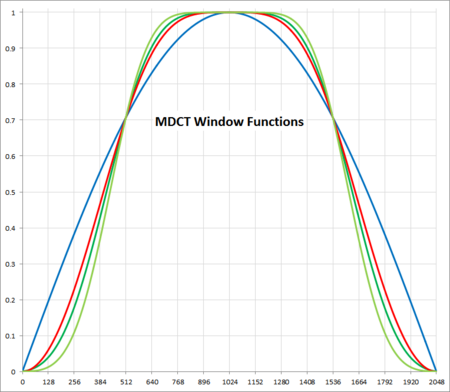
Mathematical transform using in signal processing MDCT redirects here. For the form of medical imaging, see Multidetector computed tomography. The modified discrete cosine transform (MDCT) is a transform based on the type-IV discrete cosine transform (DCT-IV), with the additional property of being lapped: it is designed to be performed on consecutive blocks of a larger dataset, where subsequent blocks are overlapped so that the last half of one block coincides with the first half of the next blo…

Ancient Greek philosopher (c. 624 тАУ c. 545 BC) Thales redirects here. For the company, see Thales Group. For other uses, see Thales (disambiguation). Thales of MiletusPosthumous portrait of Thales by Wilhelm Meyer, based on a bust from the 4th centuryBornc. 626/623 BCMiletus, Ionian League(modern-day Balat, Didim, Ayd─▒n, Turkey)Diedc. 548/545 BC (aged c. 78)EraPre-Socratic philosophyRegionWestern philosophySchoolIonian / MilesianMain interestsmetaphysicsmathematicsastronomyNotable id…
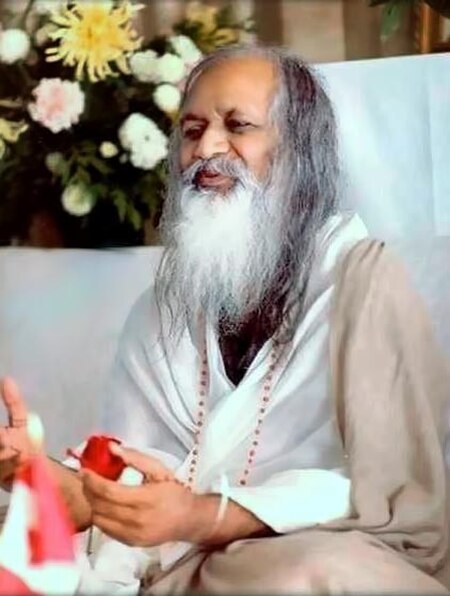
Form of silent mantra meditation Maharishi Mahesh Yogi, developer of the Transcendental Meditation technique.[1] Transcendental Meditation (TM) is a form of silent meditation developed by Maharishi Mahesh Yogi and so named to separate it from Hinduism or any other religious practice.[2][3] The TM technique involves the silent repetition of a mantra or sound, and is practiced for 15тАУ20 minutes twice per day. It is taught by certified teachers through a standard course of…

Japanese women's magazine Fujin Gah┼НCover page of the first issueFormer editorsTetsuz┼Н TanikawaCategoriesWomen's magazineFrequencyMonthlyPublisherFujin Gaho co.FounderDoppo KunikidaFounded1905First issueJuly 1905CompanyHearst CorporationCountryJapanBased inTokyoLanguageJapanese Fujin Gah┼Н (хйжф║║чФ╗ха▒; Illustrated Women's Gazette) is a Japanese language monthly women's magazine in Japan. Founded in 1905, it is one of the oldest magazines in the country. History and profile Fujin Gah┼Н was es…
┘З╪░┘З ╪з┘Д┘Е┘В╪з┘Д╪й ╪и╪н╪з╪м╪й ┘Д╪╡┘Ж╪п┘И┘В ┘Е╪╣┘Д┘И┘Е╪з╪к. ┘Б╪╢┘Д┘Л╪з ╪│╪з╪╣╪п ┘Б┘К ╪к╪н╪│┘К┘Ж ┘З╪░┘З ╪з┘Д┘Е┘В╪з┘Д╪й ╪и╪е╪╢╪з┘Б╪й ╪╡┘Ж╪п┘И┘В ┘Е╪╣┘Д┘И┘Е╪з╪к ┘Е╪о╪╡╪╡ ╪е┘Д┘К┘З╪з. ╪г┘К╪▓┘И 1 ┘З┘И ┘Е╪╣┘К╪з╪▒ ╪п┘И┘Д┘К ┘К╪н╪п╪п ╪п╪▒╪м╪й ╪з┘Д╪н╪▒╪з╪▒╪й ╪з┘Д┘Е╪▒╪м╪╣┘К╪й ╪з┘Д┘В┘К╪з╪│┘К╪й ┘Д┘Е┘И╪з╪╡┘Б╪з╪к ╪з┘Д┘Е┘Ж╪к╪м╪з╪к ╪з┘Д┘З┘Ж╪п╪│┘К╪й ┘И╪з┘Д╪к╪н┘В┘В.[1][2][3] ┘К╪к┘Е ╪е╪╡┘Д╪з╪н ╪п╪▒╪м╪й ╪з┘Д╪н╪▒╪з╪▒╪й ╪╣┘Ж╪п 20 ╪п╪▒╪м╪й ┘Е╪ж┘И┘К╪й╪М ┘И┘З┘И ┘Е╪з ┘К╪╣╪з╪п┘Д 293.15 ┘Г┘Д┘Б┘Ж ┘И 6…
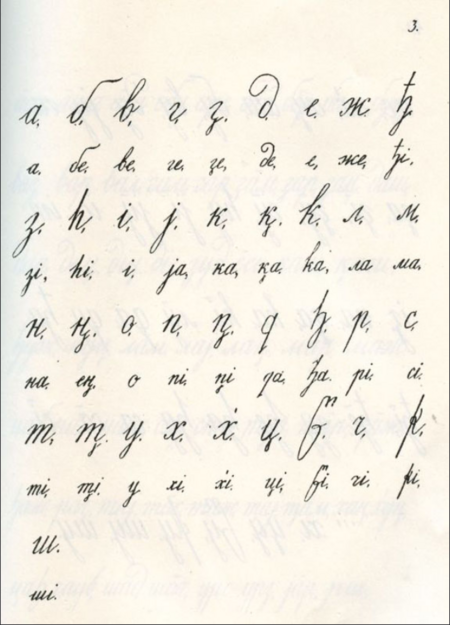
Northeast Caucasian language of Chechnya, Russia Chechen╨Э╨╛╤Е╤З╨╕╨╣╨╜ ╨╝╨╛╤В╤ВNox├зiyn mottPronunciation[╦Иn╔Фxt═б╩Г─й╦Р mu╔Фt]Native toRussiaRegionChechnya, Ingushetia, Dagestan and GeorgiaEthnicityChechensNative speakers1.8 million (2020)[1]Language familyNortheast Caucasian NakhVainakhChechenтАУIngushChechenDialects Akkin Shatoi Melkhin Kistin Cheberloi Ploskost Writing systemCyrillic script (present, official) Latin script (historically)Arabic script (historically)…




